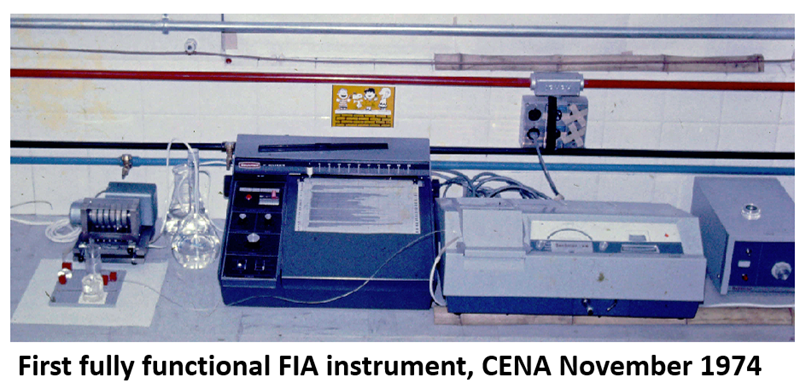2.1.9. Conclusion
Continuous Flow Injection is a widely used, efficient approach to automation of reagent-based assays and a tool for enhancement of performance of instrumental analytical techniques. It is a workhorse of agricultural and environmental laboratories where a single instrument can process up to several thousand nutrient assays per week. cFI is essential tool for research in sciences that rely on collection of large sets of data on chemical composition of investigated materials.
In oceanography, desirable attributes of FIA were recognized early on when (Johnson & Pety 1982), published their pioneering work on reversed FIA. By now cFI is widely used for determination of wide range of nutrients in sea water (Worsfold 2013), and in GEOTRACES program for mapping trace element distribution in oceans (Measures 1995).
Flow Injection Analysis of Marine Samples (2009) is a monograph, dealing in seven chapters with determination of inorganic and organic analytes in sea and estuarine water, in marine and estuarine sediments as well as in marine animals and seafood.
Flow Injection Analysis of Pharmaceuticals (1996) offers in 17 chapters a review of FIA techniques; sorbent extraction, liquid-liquid extraction, enzymatic analysis, immunoassays as well as detailed review of optical and electrochemical methods of analyte quantification.
While application of FI techniques continue to grow in scope, its concept is dated due to its invention at a time, when – hard to believe - there were no computers in the laboratory, and data were recorded as peaks on chart recorder.

The three cornerstones of FI method sample injection, controlled dispersion of sample zone and reproducible timing of sample transport from injection into detector were based on fixed volume of sampling loop and continuous movement of (peristaltic) pump. While computerization revolutionized data monitoring, calibration and calculation of results, only peripheral functions like synchronized sample injection with sample changer are now computer controlled. The fundamental processes, sample transport, sample mixing with reagents and monitoring of reaction products are controlled in the same way as they were 40 years ago.
In the next Chapter it is shown that changing from continuous to computer controlled, programmable flow format will expand versatility of Flow Injection method, it will reduce reagent consumption (and waste generation) and it will lead to development of new techniques: single standard solution calibration, and batch-flow approach that improves sensitivity and reproducibility of cFI and enables it to perform measurements well beyond the scope of serial assays.
K.S. Johnson, R.L. Petty “Determination of Phosphate in Seawater by Flow Injection Analysis with Injection of Reagent” Anal. Chem. 54, (1982) 1185.
P. J. Worsfold, R. Clough, M.L. Lohan, P. Monbet, P.S. Ellis, C.R. Quetel, et al., “Flow injection analysis as a tool for enhancing oceanographic nutrient measurements- A review”, Anal. Chim. Acta 803 (2013) 15–40
I.Ch. Measures, J. Yuan, J.A. Resing, “Determination of Iron in Sea Water by flow analysis using on line ,preconcentration and spectrophotometric detection” Marine Chemistry 50: 1-4 AUG 1995 p 3-12
M. C. Yebra-Biurrun “Flow Injection Analysis of Marine Samples”, Nova Scotia Publishers Inc. New York.
J. Martinez Calaytayud: “Flow injection Analysis of Pharmaceuticals” Taylor & Francis 1996 London.